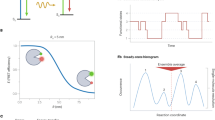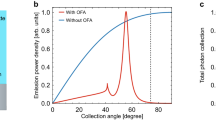Abstract
Optical studies of individual molecules at low and room temperature can provide information about the dynamics of local environments in solids, liquids and biological systems unobscured by ensemble averaging1,2,3,4,5,6,7,8,9,10,11,12,13,14. Here we present a study of the photophysical behaviour of single molecules of the green fluorescent protein (GFP) derived from the jellyfish Aequorea victoria. Wild-type GFP and its mutant have attracted interest as fluorescent biological labels because the fluorophore may be formed in vivo15,16. GFP mutants immobilized in aereated aqueous polymer gels and excited by 488-nm light undergo repeated cycles of fluorescent emission (‘blinking’) on a timescale of several seconds—behaviour that would be unobservable in bulk studies. Eventually the individual GFP molecules reach a long-lasting dark state, from which they can be switched back to the original emissive state by irradiation at 405 nm. This suggests the possibility of using these GFPs as fluorescent markers for time-dependent cell processes, and as molecular photonic switches or optical storage elements, addressable on the single-molecule level.
This is a preview of subscription content, access via your institution
Access options
Subscribe to this journal
Receive 51 print issues and online access
$199.00 per year
only $3.90 per issue
Buy this article
- Purchase on Springer Link
- Instant access to full article PDF
Prices may be subject to local taxes which are calculated during checkout





Similar content being viewed by others
References
Moerner, W. E. & Kador, L. Optical detection and spectroscopy of single molecules in a solid. Phys. Rev. Lett. 62, 2535–2538 (1989).
Orrit, M. & Bernard, J. Single pentacene molecules detected by fluorescence excitation in a p-terphenyl crystal. Phys. Rev. Lett. 65, 2716–2719 (1990).
Reilly, P. D. & Skinner, J. L. Spectral diffusion of single molecule fluorescence: a probe of low-frequency localized excitations in disordered crystals. Phys. Rev. Lett. 71, 4257–4260 (1993).
Moerner, W. E. Examining nanoenvironments in solids on the scale of a single, isolated molecule. Science 265, 46–53 (1994).
Barbara, P. F. & Moerner, W. E. (eds Single molecules and atoms. Acc. Chem. Res. 29, (1996).
Betzig, E. & Chichester, R. J. Single molecules observed by near-field scanning optical microscopy. Science 262, 1422–1428 (1993).
Ambrose, W. P., Goodwin, P. M., Martin, J. C. & Keller, R. A. Alterations of single molecule fluorescence lifetimes in near-field optical microscopy. Science 265, 364–367 (1994).
Nie, S., Chiu, D. T. & Zare, R. N. Probing individual molecules with confocal fluorescence microscopy. Science 266, 1018–1021 (1994).
Trautman, J. K. & Macklin, J. J. Time-resolved spectroscopy of single molecules using near-field and far-field optics. Chem. Phys. 205, 221–229 (1996).
Lu, H. P. & Xie, X. S. Single-molecule spectral fluctuations at room temperature. Nature 385, 143–146 (1997).
Funatsu, T., Harada, Y., Tokunaga, M., Saito, K. & Yanagida, T. Imaging of single fluorescent molecules and individual ATP turnovers by single myosin molecules in aqueous solution. Nature 374, 555–559 (1995).
Vale, R. D. et al. Direct observation of single kinesin molecules moving along microtubules. Nature 380, 451–453 (1996).
Schmidt, T., Schutz, G. J., Baumgartner, W., Gruber, H. J. & Schindler, H. Imaging of single molecule diffusion. Proc. Natl Acad. Sci. USA 93, 2926–2929 (1996).
Basché, T., Moerner, W. E., Orrit, M. & Wild, U. P. (eds Single Molecule Optical Detection, Imaging, and Spectroscopy(Verlag-Chemie, Munich, (1997)).
Heim, R., Prasher, D. C. & Tsien, R. Y. Wavelength mutations and posttranslational autoxidation of green fluorescent protein. Proc. Natl Acad. Sci. USA 91, 12501–12504 (1994).
Cubitt, A. B. et al. Understanding, improving and using green fluorescent proteins. Trends Biochem. Sci. 20, 448–455 (1995).
Chattoraj, M., King, B. A., Bublitz, G. U. & Boxer, S. G. Ultra-fast excited state dynamics in green fluorescent protein: Multiple states and protein transfer. Proc. Natl Acad. Sci USA 93, 8362–8367 (1996).
Brejc, K. et al. Structural basis for dual excitation and photoisomerization of the Aequorea victoria green fluorescent protein. Proc. Natl. Acad. USA 94, 2306–2322 (1997).
Ormo, M. et al. Crystal structure of the Aequorea victoria green fluorescent protein. Science 273, 1392–1395 (1996).
Yang, F., Moss, L. G. & Phillips, J. G. N. The molecular structure of green fluorescent protein. Nature Biotechnol. 14, 1246–1251 (1996).
Dickson, R. M., Norris, D. J., Tzeng, Y. -L. & Moerner, W. E. Three dimensional imaging of single molecules in pores of poly(acrylamide) gels. Science 274, 966–969 (1996).
Moerner, W. E. et al. Optical probing of single molecules of terrylene in a Shpolskii matrix—a two-state single-molecule switch. J. Phys. Chem. 98, 7382–7389 (1994).
Stuart, J. A., Tallent, J. R., Tan, E. H. L. & Birge, R. R. in Sixth Biennial IEEE Intl Nonvolatile Memory Technol. Conf. Proc. 35–51 (IEEE, Albuquerque, NM, (1996)).
Sakmann, B. & Neher, E. Single Channel Recording(Plenum, New York, (1995)).
Yokoe, H. & Meyer, T. Spatial dynamics of GFP-tagged proteins investigated by local fluorescence enhancement. Nature Biotechnol. 14, 1252–1256 (1996).
Irie, M. in Photo-reactive Materials for Ultrahigh Density Optical Memory(ed. Irie, M.) 1–12 (Elsevier Science, Amsterdam, (1994)).
Parthenopoulos, D. A. & Rentzepis, P. M. Three-dimensional optical storage memory. Science 245, 843–845 (1989).
Kunkel, T. A., Roberts, J. D. & Zakour, R. A. Rapid and efficient site-specific mutagenesis without phenotypic selection. Meth. Enzymol. 154, 367–382 (1987).
Fawcett, J. S. & Morris, C. J. O. R. Molecular-sieve chromatography of proteins on granulated polyacrylamide gels. Separat. Sci. 1, 9–26 (1966).
Box, G. E. P. & Jenkins, G. M. Time Series Analysis Forecasting and Control(Holden-Day, San Francisco, (1970)).
Acknowledgements
We thank L. S. B. Goldstein and S. Kummer for discussions. This work was supported by the NSF.
Author information
Authors and Affiliations
Corresponding author
Rights and permissions
About this article
Cite this article
Dickson, R., Cubitt, A., Tsien, R. et al. On/off blinking and switching behaviour of single molecules of green fluorescent protein. Nature 388, 355–358 (1997). https://doi.org/10.1038/41048
Received:
Accepted:
Issue Date:
DOI: https://doi.org/10.1038/41048
This article is cited by
-
Long-term super-resolution inner mitochondrial membrane imaging with a lipid probe
Nature Chemical Biology (2024)
-
Indefinite and bidirectional near-infrared nanocrystal photoswitching
Nature (2023)
-
Structural and photophysical characterization of the small ultra-red fluorescent protein
Nature Communications (2023)
-
Optical control of ultrafast structural dynamics in a fluorescent protein
Nature Chemistry (2023)
-
First biphotochromic fluorescent protein moxSAASoti stabilized for oxidizing environment
Scientific Reports (2022)
Comments
By submitting a comment you agree to abide by our Terms and Community Guidelines. If you find something abusive or that does not comply with our terms or guidelines please flag it as inappropriate.



